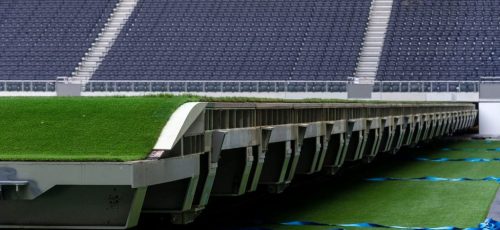Why Early Stage Collaboration Matters In Kinetic Stadium Design
Lily Mckeown | 6th August 2025

The Challenges of Designing Kinetic Stadium Elements
Today’s stadiums are expected to be more than venues they’re immersive experiences. Architects are under constant pressure to push the boundaries of innovation, fan experience and practicality, all while staying on time and on budget.
Kinetic features such as moving roofs, retractable pitches and sliding stands can transform how a stadium functions, dramatically increasing its versatility and appeal. Yet these features come with significant engineering and operational complexity.
The biggest challenge lies in ensuring that an ambitious design vision can be translated into safe, reliable motion systems. Every moving element introduces risks, from mechanical tolerances to long-term maintenance demands, which must be resolved without compromising aesthetics or performance.
Without early specialist input, projects often face late-stage redesigns, schedule delays and escalating costs. Engaging experts in kinetic systems from the outset helps mitigate these risks, creating a smoother path from concept to completion and ultimately ensuring that stadiums deliver on their promise of innovation and exceptional fan experiences
Why ARX Adds Value at the Concept Stage
Avoid redesigns
Cost savings
Design freedom
Smarter integration

The ARX Process – From Design Intent to Motion Delivery
Delivering complex kinetic features requires more than engineering expertise it calls for a structured, collaborative process that integrates creativity and technical rigour from day one. At ARX, our approach is built on four pillars:
1. Co-Creation from the Start
We begin with facilitated workshops and design charrettes alongside architects, stadium planners and key stakeholders. These sessions help clarify intent, explore innovative options and identify early risks. By aligning on goals and constraints at the outset, we reduce design friction later and protect the project’s original vision.
2. Advanced Digital Tools
Our team employs a suite of digital modelling, feasibility simulations and motion analyses to bring kinetic concepts to life in a virtual environment. This allows us to test dynamic performance, assess structural and operational stresses and fine-tune tolerances long before fabrication begins. Early modelling also enables stakeholders to visualise how moving elements will interact with other building systems and the fan experience.
3. Transparent, Data-Driven Process
At every stage of development, we conduct rigorous feasibility checks, cost/benefit analyses, and risk assessments. This transparency gives decision-makers the confidence to proceed with innovative features while maintaining budget discipline and regulatory compliance. Our documentation provides a clear audit trail that supports future maintenance and operational planning.
4. Predictable Outcomes and Reduced Risk
By integrating co-creation, advanced modelling, and transparent governance, ARX delivers a smoother, more predictable journey from concept sketches to fully realised kinetic structures. The result: fewer late-stage design changes, reduced project risk, and motion systems that perform reliably and safely over their lifecycle.
With this disciplined yet creative approach, ARX ensures that every kinetic stadium element is not only technically feasible but also a seamless extension of the architect’s vision. Take a look at some examples of our work below:
Real Examples of Early Collaboration Shaping Outcomes:
The Risks of Late Engagement
In complex projects, timing is everything and nowhere is this more evident than in the integration of kinetic or specalist engineering systems. When these systems are brought in after the design freeze , teams often find themselves making compromises on design intent, performance and cost. Instead of enhancing the project, late-stage integration can result in awkward layouts, reduced efficency and higher capital expenditure.
Retrofitting kinetic systems at a late stage also means lost opportunities for innovation. Early involvement of engineering partners allows for creative problem-solving, material optimisation and seamless coordination between disciplines. When these conversations happen too late, the scope for inventive solutions narrows, often forcing teams into “engineering workarounds” rather than elegant, integrated solutions.
Perhaps most importantly, early collaboration protects the architectural vision. By engaging kinetic or specialist engineers from the start, you ensure the mechanics serve the architecture, not the other way around. This approach preserves the integrity of the design, avoids costly redesigns, and results in a final product that performs as beautifully as it looks.




The Payoff – Why Architects Benefit from Early Engagement with ARX
Confidence that design intent will be delivered as imagined
With ARX involved from the outset, architects and designers can trust that their original creative vision will be faithfully translated into the finished structure. Our expertise ensures that complex designs don’t have to be compromised during engineering and construction every detail is planned, tested, and executed to align with the initial intent.
Access to ARX’s experience in stadia-specific motion systems
ARX brings decades of specialist knowledge in designing and engineering motion systems for stadium environments. This means our partners gain immediate access to tried-and-tested solutions, cutting-edge technology, and the lessons learned from past high-profile projects. By leveraging our experience, you reduce project risk and accelerate timelines.
Peace of mind: proven engineering behind ambitious concepts
Ground breaking ideas require rock-solid engineering. ARX backs bold architectural concepts with robust, proven systems and rigorous testing. This gives stakeholders the reassurance that their investment is secure, functionality is reliable and safety remains paramount, even for the most ambitious designs.
Stronger client relationships by demonstrating feasibility and innovation upfront
By using our engineering expertise early in the process, we help our clients demonstrate feasibility and innovation to their own stakeholders. This upfront collaboration builds trust, encourages creative risk-taking and sets the stage for a smoother project journey, ultimately strengthening long-term relationships.
Let’s shape the future of stadium design together – Contact us via the form below to discuss your project or explore partnership opportunities.